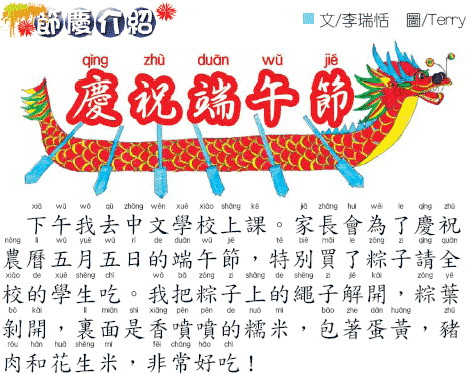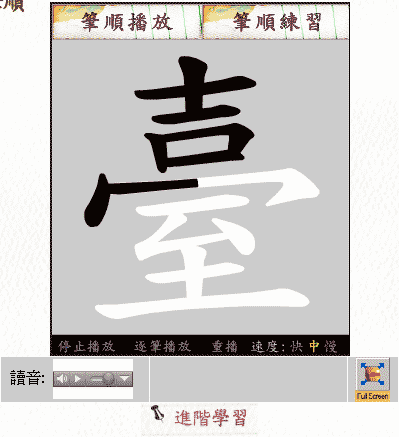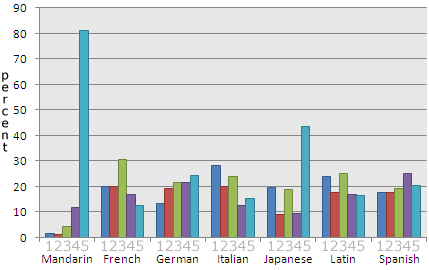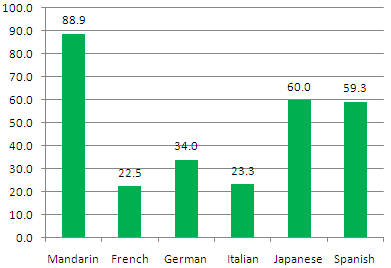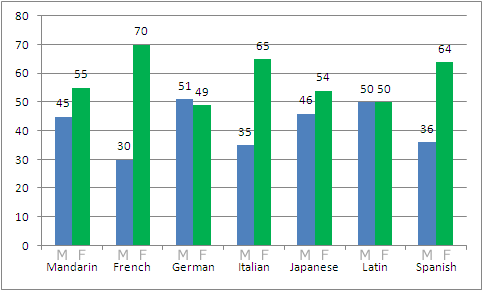Ozaru‘s link in a comment on my previous post led me eventually to a report on “community languages” in higher education in Britain. The report provides numbers for those in degree programs for various foreign languages.
Students accepted on U.K. language-degree courses, 1996-2007
| Language | 1996 | 2001 | 2005 | 2007 | % change 1996-2007 | % of total in 1996 | % of total in 2007 |
|---|---|---|---|---|---|---|---|
| French | 5655 | 4077 | 3964 | 3700 | -34.57 | 33.02 | 28.83 |
| Italian | 837 | 786 | 639 | 2461 | 194.03 | 4.89 | 19.18 |
| Spanish | 2155 | 2331 | 2547 | 1401 | -34.99 | 12.58 | 10.92 |
| German | 2288 | 1736 | 1503 | 610 | -73.34 | 13.36 | 4.75 |
| Russian and Eastern European | 418 | 380 | 425 | 409 | -2.15 | 2.44 | 3.19 |
| Mandarin | 165 | 165 | 352 | 392 | 137.58 | 0.96 | 3.05 |
| Modern Middle Eastern | 214 | 260 | 362 | 378 | 76.64 | 1.25 | 2.95 |
| Japanese | 272 | 249 | 331 | 306 | 12.50 | 1.59 | 2.38 |
| Portuguese | 128 | 117 | 118 | 141 | 10.16 | 0.75 | 1.10 |
| Other Asian | 161 | 171 | 142 | 118 | -26.71 | 0.94 | 0.92 |
| African | 54 | 57 | 57 | 67 | 24.07 | 0.32 | 0.52 |
| Scandinavian | 65 | 36 | 57 | 19 | -70.77 | 0.38 | 0.15 |
| Other European | 2200 | 1507 | 1667 | 1647 | -25.14 | 12.85 | 12.83 |
| Other non-European | 2514 | 1900 | 1248 | 1185 | -52.86 | 14.68 | 9.23 |
| ALL | 17126 | 13772 | 13412 | 12834 | -25.06 | 100 | 100 |
(Adapted from Table 3.3 in the report)
If I understand the report correctly, the figures are not for total enrollments, just for students majoring or minoring in the languages in question. Thus, the actual enrollment numbers are likely much higher, though certainly not distributed evenly across the languages.
I’m pleased to note that the number of students in Mandarin programs has more than doubled in the last dozen years, though this doesn’t match the even more impressive growth rate for Italian. (I have no idea why Italian received such a boost, especially during a period in which most other European languages were shedding students.)
Mandarin now ranks sixth (or perhaps fifth, depending on how many Polish majors there are) among foreign language majors, with 3 percent of foreign language majors concentrating on this.
On the other hand, because native English speakers must devote a great deal more time and effort to learning Mandarin than most other languages, the levels of learning and achievement aren’t the same. Simply put, for most native English speakers Mandarin is damn hard, and students won’t gain nearly the same level of fluency in four years as they would studying most other languages.
For example, in 2002 Goldsmiths, University of London, which is the “largest provider of community languages in a PGCE,” set up its Postgraduate Certificate in Education in community languages, starting with Arabic, Mandarin, and Punjabi, and adding Urdu in 2004. So far all of the students enrolled in the Mandarin program have had “some knowledge of the language as a community/family/heritage language.” In other words, most — perhaps all — students have been ethnic Chinese and have a background in the language beyond the classroom.
Although the College does not especially seek to attract students who have some knowledge of the language as a community/family/heritage language, all the students accepted so far do have this background. This may change in the next five to ten years, as more non-native speaker students graduate with UK degrees in Mandarin, and some may wish to go on to teach it. However, this will only take place if there is good progression in the language from school to university level so that graduates can reach a high enough level in the language to teach up to A level. Currently, this is not the case, and those who have applied so far do not have this level of expertise.
Ouch. So it’s not that non-Chinese didn’t apply to the program, it’s that none of them were judged up to the requisite level of fluency to teach the language, despite having attained university degrees in Mandarin. (This only reinforces my worry about the drop in graduate enrollments in Mandarin in the United States.)
The report also notes, “There are no degree courses in the four most widely used community languages in England: Urdu, Cantonese, Punjabi and Bengali, although SOAS will offer a degree course in Bengali from autumn 2008.”
The situation is more promising for those taking A-levels in “Chinese.” (NB: The chart does not distinguish between Cantonese and Mandarin — even though these have separate oral exams — but lumps them together as “Chinese.” The majority will likely be Cantonese.)
presentations in the main community languages for GCSE and A-level examinations in 2007

(The figures for Spanish have not been included in the chart because it seems likely that most pupils study this as a foreign language rather than a community language: in 2007, 63,978 candidates sat GCSE and 7,152 A-level Spanish. Hindi is not included in this chart as it is not available at GCSE or A-Level.)
The total number of A-Level presentations in these languages in 2007 is 5347, indicating potential numbers in a good position to continue their studies in these languages in higher education. The ‘retention rate’ for most of languages listed above is high. This is a percentage calculated by comparing the numbers sitting a GCSE examination in a given year compared with those sitting an A-level in the same language two years later. It has to be regarded as a proxy measure, however, as not all those sitting A-levels took the relevant examination two years earlier. The retention rate over all languages (i.e. including French, German and Spanish), between GCSEs sat in 2005 and A-levels in 2007, is 7.5%. Most of the languages likely to be studied as community languages have a retention rate considerably higher than those typically studied as ‘foreign’ languages. Chinese is the most spectacular, with a retention rate of 78%, followed by Polish (51%) and Russian (42%). Only Bengali (3%) and Punjabi (4%) have retention rates below the overall figure. The high retention rate for the majority indicates that community language learners can, generally speaking, be regarded as committed students, and potentially good candidates for continued study of these languages in higher education.
source:
- Community Languages in Higher Education — Towards realising the potential — A Report for the Routes into Languages Initiative, January 2008
further reading:
- US post-secondary enrollments in foreign languages and the position of Mandarin, Pinyin News, August 2008
- Results of US AP exams: first year for Mandarin, Japanese, Pinyin News, February 2008


